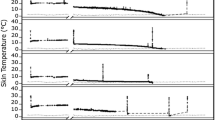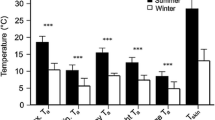Abstract
Bats are among the most successful groups of Australian arid-zone mammals and, therefore, must cope with pronounced seasonal fluctuations in ambient temperature (T a), food availability and unpredictable weather patterns. As knowledge about the energy conserving strategies in desert bats is scant, we used temperature-telemetry to quantify the thermal physiology of tree-roosting inland freetail bats (Mormopterus species 3, 8.5 g, n = 8) at Sturt National Park over two summers (2010–2012), when T a was high and insects were relatively abundant. Torpor use and activity were affected by T a. Bats remained normothermic on the warmest days; they employed one “morning” torpor bout on most days and typically exhibited two torpor bouts on the coolest days. Overall, animals employed torpor on 67.9 % of bat-days and torpor bout duration ranged from 0.5 to 39.3 h. At any given T a, torpor bouts were longer in Mormopterus than in bats from temperate and subtropical habitats. Furthermore, unlike bats from other climatic regions that used only partial passive rewarming, Mormopterus aroused from torpor using either almost entirely passive (68.9 % of all arousals) or active rewarming (31.1 %). We provide the first quantitative data on torpor in a free-ranging arid-zone molossid during summer. They demonstrate that this desert bat uses torpor extensively in summer and often rewarms passively from torpor to maximise energy and water conservation.





Similar content being viewed by others
Abbreviations
- T a :
-
Ambient temperature
- T skin :
-
Skin temperature
- T b :
-
Body temperature
- TBD:
-
Torpor bout duration
References
Adams M, Reardon TR, Baverstock PR, Watts CHS (1988) Electrophoretic resolution of species boundaries in Australian Microchiroptera. IV. The molossidae (Chiroptera). Aust J Biol Sci 41:315–326
Barclay RMR, Kalcounis MC, Crampton LH, Stefan C, Vonhof MJ, Wilkinson L, Brigham RM (1996) Can external radiotransmitters be used to assess body temperature and torpor in bats? J Mammal 77:1102–1106
Barclay RMR, Lausen CL, Hollis L (2001) What’s hot and what’s not: defining torpor in free-ranging birds and mammals. Can J Zool 79:1885–1890
Ben-Hamo M, Munoz-Garcia A, Williams JB, Korine C, Pinshow B (2013) Waking to drink: rates of evaporative water loss determine arousal frequency in hibernating bats. J Exp Biol 216:573–577
Chruszcz BJ, Barclay RMR (2002) Thermoregulatory ecology of a solitary bat, Myotis evotis, roosting in rock crevices. Funct Ecol 16:18–26
Churchill S (2008) Australian bats, 2nd edn. Allen & Unwin, Crows Nest
Cooper CE, McAllan BM, Geiser F (2005) Effect of torpor on the water economy of an arid-zone marsupial, the stripe-faced dunnart (Sminthopsis macroura). J Comp Physiol B 175:323–328
Dausmann KH, Glos J, Ganzhorn JU, Heldmaier G (2005) Hibernation in the tropics: lessons from a primate. J Comp Physiol B 175:147–155
Doucette LI, Brigham RM, Pavey CR, Geiser F (2012) Prey availability affects daily torpor by free-ranging Australian owlet-nightjars (Aegotheles cristatus). Oecologia 169:361–372
Geiser F (2004) The role of torpor in the life of Australian arid zone mammals. Aust Mammal 26:125–134
Geiser F, Brigham RM (2000) Torpor, thermal biology, and energetics in Australian long-eared bats (Nyctophilus). J Comp Physiol B 170:153–162
Geiser F, Brigham RM (2012) The other functions of torpor. In: Ruf T, Bieber C, Arnold W, Millesi E (eds) Living in a seasonal world. 14th International Hibernation Symposium. Springer, Heidelberg, pp 109–121
Geiser F, Drury RL (2003) Radiant heat affects thermoregulation and energy expenditure during rewarming from torpor. J Comp Physiol B 173:55–60
Hickey MBC, Fenton MB (1996) Behavioural and thermoregulatory responses of female hoary bats, Lasiurus cinereus (Chiroptera: Vespertilionidae), to variations in prey availability. Écoscience 3:414–422
Hill JE, Smith JD (1988) Bats a natural history. British Museum (Natural History), London
Hock RJ (1951) The metabolic rates and body temperatures of bats. Biol Bull 101:289–299
Hosken DJ, Withers PC (1997) Temperature regulation and metabolism of an Australian bat, Chalinolobus gouldii (Chiroptera: Vespertilionidae) when euthermic and torpid. J Comp Physiol B 167:71–80
Körtner G, Geiser F (1998) Ecology of natural hibernation in the marsupial mountain pygmy-possum (Burramys parvus). Oecologia 113:170–178
Körtner G, Geiser F (2009) The key to winter survival: daily torpor in a small arid-zone marsupial. Naturwissenschaften 96:525–530
Kunz TH (1982) Roosting ecology of bats. In: Kunz TH (ed) Ecology of bats. Plenum Press, New York, pp 1–55
Levy O, Dayan T, Kronfeld-Schor N (2011) Adaptive thermoregulation in golden spiny mice: the influence of season and food availability on body temperature. Physiol Biochem Zool 84:175–184
Lovegrove BG (2000) Daily heterothermy in mammals: coping with unpredictable environments. In: Heldmaier G, Klingenspor M (eds) Life in the cold. 11th International Hibernation Symposium. Jungholz, Austria, pp 29–40
Lovegrove BG, Körtner G, Geiser F (1999) The energetic cost of arousal from torpor in the marsupial Sminthopsis macroura: benefits of summer ambient temperature cycles. J Comp Physiol B 169:11–18
Maloney SK, Bronner GN, Buffenstein R (1999) Thermoregulation in the Angolan free-tailed bat Mops condylurus: a small mammal that uses hot roosts. Physiol Biochem Zool 72:385–396
Meyer CFJ, Schwarz CJ, Fahr J (2004) Activity patterns and habitat preferences of insectivorous bats in a West African forest-savanna mosaic. J Trop Ecol 20:397–407
Milne DJ, Fisher A, Rainey I, Pavey CR (2005) Temporal patterns of bats in the top end of the Northern Territory, Australia. J Mammal 86:909–920
Munn AJ, Kern P, McAllan BM (2010) Coping with chaos: unpredictable food supplies intensify torpor use in an arid-zone marsupial, the fat-tailed dunnart (Sminthopsis crassicaudata). Naturwissenschaften 97:601–605
R development Core Team (2012) R: a language and environment for statistical computing. R Foundation for Statistical Computing, Vienna
Riek A, Geiser F (2013) Allometry of thermal variables in mammals: consequences of body size and phylogeny. Biol Rev Camb Philos Soc 88:564–572
Schmid J, Speakman JR (2000) Daily energy expenditure of the grey mouse lemur (Microcebus murinus): a small primate that uses torpor. J Comp Physiol B 170:633–641
Schmid J, Speakman JR (2009) Torpor and energetic consequences in free-ranging grey mouse lemurs (Microcebus murinus): a comparison of dry and wet forests. Naturwissenschaften 96:609–620
Schmidt-Nielsen K (1979) Desert animals: physiological problems of heat and water. Dover Publications, New York
Serventy V, Raymond R (1973) Torpidity in desert animals. Aust Wildl Heritage 14:2233–2240
Stawski C, Geiser F (2010a) Fat and fed: frequent use of summer torpor in a subtropical bat. Naturwissenschaften 97:29–35
Stawski C, Geiser F (2010b) Seasonality of torpor patterns and physiological variables of a free-ranging subtropical bat. J Exp Biol 213:393–399
Stawski C, Turbill C, Geiser F (2009) Hibernation by a free-ranging subtropical bat (Nyctophilus bifax). J Comp Physiol B 179:433–441
Taylor LR (1963) Analysis of the effect of temperature on insects in flight. J Anim Ecol 32:99–117
Taylor RJ, O’Neill MG (1988) Summer activity patterns of insectivorous bats and their prey in Tasmania. Aust Wildl Res 15:533–539
Thomas DW, Geiser F (1997) Periodic arousals in hibernating mammals: is evaporative water loss involved? Funct Ecol 11:585–591
Turbill C (2006) Thermoregulatory behavior of tree-roosting chocolate wattled bats (Chalinolobus morio) during summer and winter. J Mammal 87:318–323
Turbill C, Geiser F (2008) Hibernation by tree-roosting bats. J Comp Physiol B 178:597–605
Turbill C, Körtner G, Geiser F (2003a) Natural use of heterothermy by a small, tree-roosting bat during summer. Physiol Biochem Zool 76:868–876
Turbill C, Law BS, Geiser F (2003b) Summer torpor in a free-ranging bat from subtropical Australia. J Therm Biol 28:223–226
Vivier L, van der Merwe M (2007) The incidence of torpor in winter and summer in the Angolan free-tailed bat, Mops condylurus (Microchiroptera: Molossidae), in a subtropical environment, Mpumulanga, South Africa. Afr Zool 42:50–58
Warnecke L, Turner JM, Geiser F (2008) Torpor and basking in a small arid zone marsupial. Naturwissenschaften 95:73–78
Withers PC (1992) Comparative animal physiology. Saunders College Publishing, Philadelphia
Zar JH (1996) Biostatistical analysis. Prentice Hall, Englewood Cliffs
Acknowledgments
Special thanks go to Ingrid Witte and the New South Wales National Parks and Wildlife Service for providing accommodation, a quad bike and help with organising the field work. Ulrike Klöcker, Barb Hawerkamp and Dan Hough helped during the field work. We are grateful to Chris Turbill for permission to use his data on Nyctophilus geoffroyi. Stuart Cairns and Thomas Ruf helped and advised with statistical procedures. Daniella Rojas and Shannon Currie helped with different aspects of this project. The research was conducted under permits from the New South Wales National Parks and Wildlife Service and the UNE Animal Ethics Committee. Financial support was received from the University of New England to AB and the Australian Research Council to FG.
Author information
Authors and Affiliations
Corresponding author
Additional information
Communicated by I.D. Hume.
Rights and permissions
About this article
Cite this article
Bondarenco, A., Körtner, G. & Geiser, F. Some like it cold: summer torpor by freetail bats in the Australian arid zone. J Comp Physiol B 183, 1113–1122 (2013). https://doi.org/10.1007/s00360-013-0779-7
Received:
Revised:
Accepted:
Published:
Issue Date:
DOI: https://doi.org/10.1007/s00360-013-0779-7




